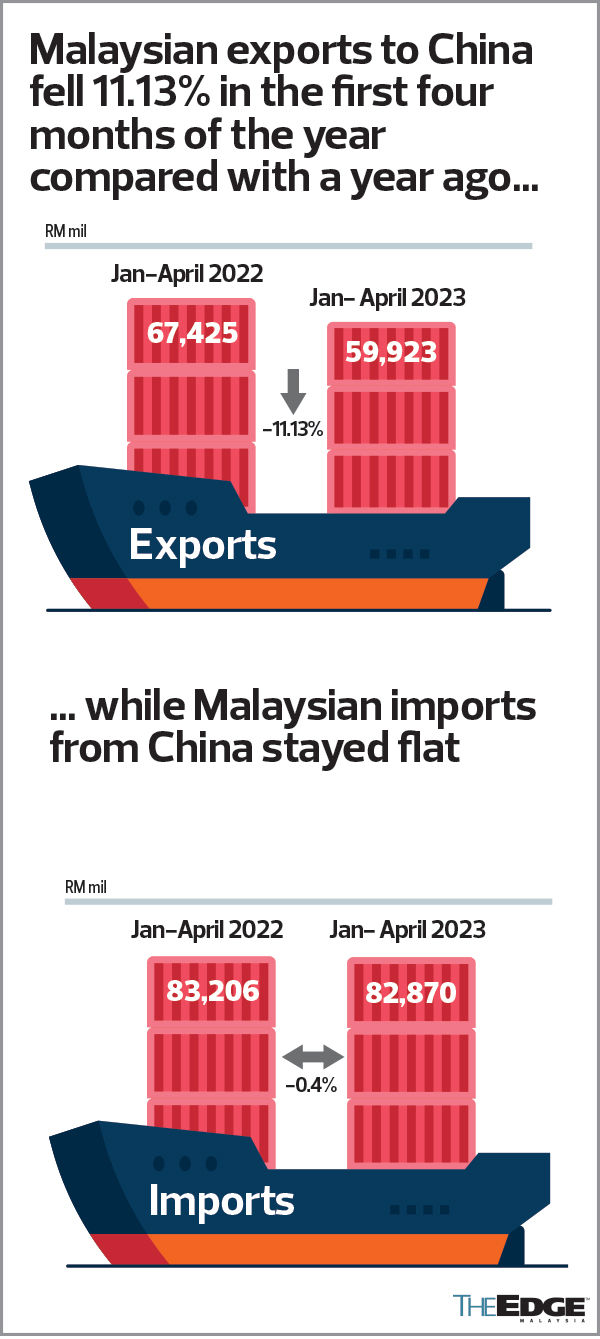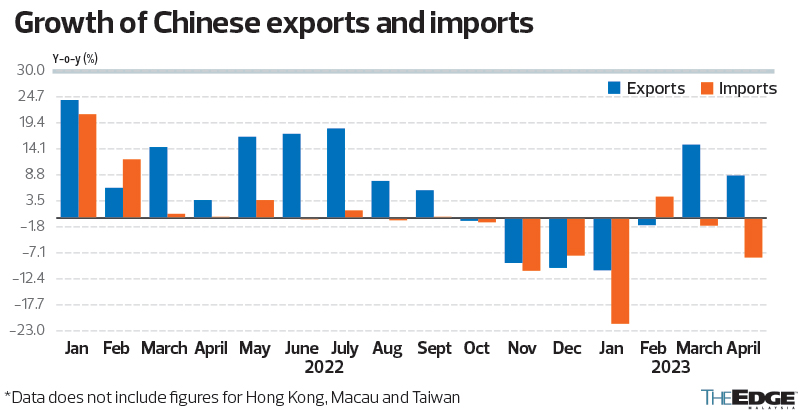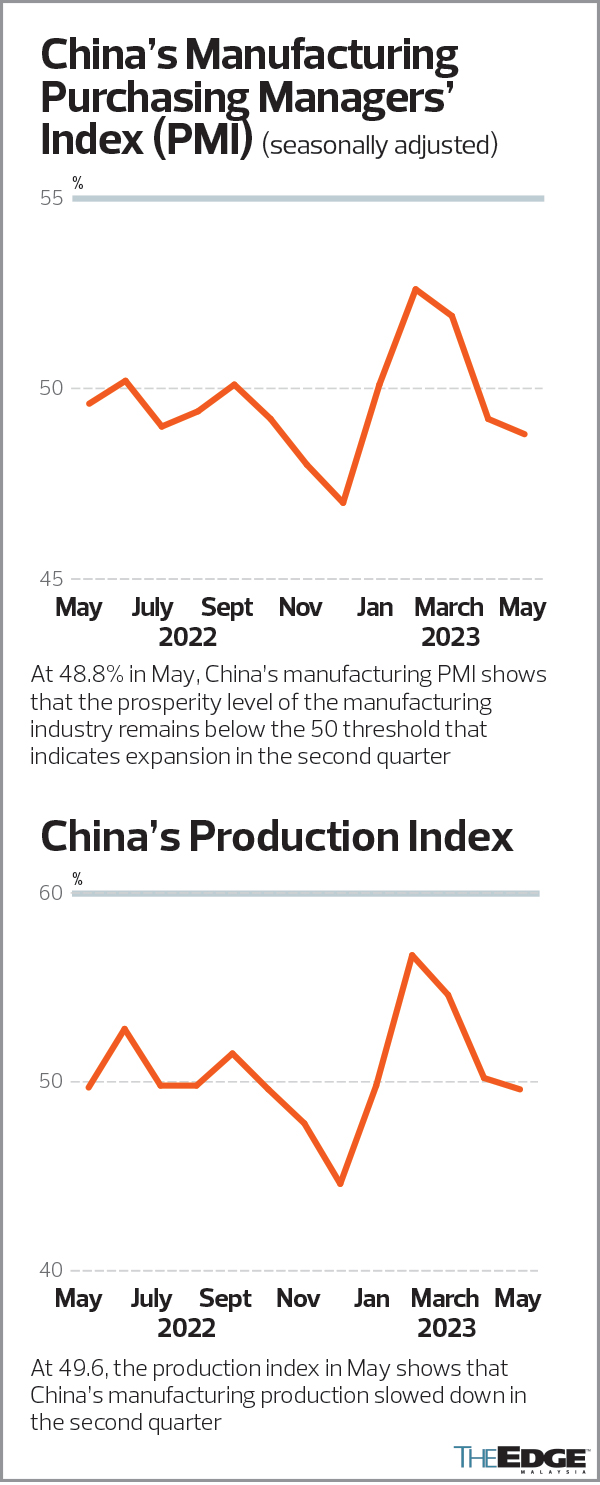
This article first appeared in The Edge Malaysia Weekly on June 12, 2023 - June 18, 2023
JUDGING from economic data released so far, there is continued weakness in China’s economy, which spells a bumpy road ahead for its major trading partners, including Malaysia.
The April and May Manufacturing Purchasing Managers’ Index (PMI), the Import Index and the Purchase Quantity Index all point to a decline in China’s industrial production in the second quarter of the year (see charts). As China is Malaysia’s largest trading partner, this has severe ramifications for the latter’s economy.
Between January and April, Malaysian exports to China by value decreased 11.13% year on year to RM59.92 billion.
Meanwhile, Chinese data shows that China’s imports have been falling since March (see charts).
Clearly, China’s economy is not in good shape at the moment, crushing all expectations that the country’s reopening, after abandoning its zero Covid-19 policy late last year, would create a rising tide of demand for products and services, thus lifting much of the world’s economic performance.
“China’s sharp economic slowdown can have a significant spillover effect on Malaysia, which has close trade links with China and is also a major commodity exporter to the country,” says Lee Heng Guie, executive director at the Socio-Economic Research Centre, the Associated Chinese Chambers of Commerce and Industry of Malaysia.
“In addition, the spike in global financial volatility associated with the unfavourable economic growth in China could drag down the already slowing global economy, and transmit financial shocks internationally.”
China has been Malaysia’s top trading partner for 13 consecutive years since 2009. The value of trade between the two countries hit a record high of RM487.1 billion in 2022, translating into an annual 10.8% increase since 2009.
In the first quarter of the year, Malaysia’s total value of trade with China amounted to RM108.7 billion, accounting for 16.8% of total external trade — intertwining the country’s economic prospects with its largest trading partner.
A scenario study by the International Monetary Fund (IMF) indicates that Malaysia is among those with the largest correlation with China’s economy, with growth falling between 0.4 and 0.5 percentage point in response to a one percentage point fall in China’s growth.
The popular phrase that the world catches a cold when the US sneezes is today just as applicable to China, which in 2010 overtook Japan as the world’s second largest economy. In today’s context, when China sneezes, the Asian region, including Malaysia, catches a cold.
Apart from the interest rate differential between the US and Malaysia as well as the spectre of a US debt ceiling crisis earlier, many have blamed the decline in the ringgit against the greenback in recent weeks on the weakness in the yuan, given Malaysia’s close trade links with China.
From a year-to-date low of 4.244 at end-January, the US dollar had strengthened to 4.612 against the ringgit on June 9, with some analysts saying 5.00 to the greenback is not impossible.
“The movement of regional currencies, including that of the ringgit and the Singapore dollar, is deemed to be tracking that of the renminbi closely, given the close trade links of the two countries with China, and also due to the increasing share of the renminbi as a reserve currency in their central banks’ basket of foreign reserve currencies,” says Lee.
Interestingly, the Malaysian economy is still posting decent growth. In the first quarter of the year, it expanded 5.6%, comparing favourably with Indonesia’s 5%, China’s 4.5% and Vietnam’s 3.3%.
But with weaker-than-expected economic data coming out of China, is slower economic growth for the region on the horizon?
Dr Afzanizam Abdul Rashid, chief economist and social finance head at Bank Muamalat Malaysia Bhd, says he is not ready to lower his 2023 GDP forecast for China. “Not yet. My base case is that China might continue to grow around 5%. If lower than that, certainly, I have to make an adjustment to our GDP forecast [for Malaysia] of 4.5%,” he tells The Edge.
The data has not been encouraging. Malaysia’s exports to China declined 6.2% y-o-y in March and contracted further by 19.9% in April. Overall, exports shrank 17.37% in April compared with -1.44% in March.
Malaysia’s Industrial Production Index (IPI) recorded its first decline since August 2021 in April, falling 3.3% y-o-y compared with an expansion of 3.2% in March. In April, all major sectors within the index — mining, manufacturing and electricity generation — recorded a contraction.
Commenting on the IPI, MIDF Research says in a report that the negative IPI growth in April was generally in line with its expectation.
“Sustained domestic demand will support domestic-driven sectors, in contrast to a more cautious approach by trade-oriented sectors to manage production in anticipation of soft overseas demand. With uncertainties and downside risks mainly coming from the external front, we are monitoring closely the strength of China’s economic recovery, the effects of geopolitical and trade tensions between the US and China, as well as the trend in global inflation, which could translate into continued weakness in external demand.”
China’s property sector a concern
In assessing the impact of slower-than-expected growth in China, it is important to consider the actions taken by its government to support economic growth. A major sector that has contributed to the increasing wealth of the Chinese population is property. However, this sector has not been performing well for a while now.
According to the National Bureau of Statistics, investments in real estate developments in China fell 6.2% y-o-y to RMB3,551.4 billion in the first quarter of the year while investments in residential buildings dropped 4.9% y-o-y to RMB2,707.2 billion.
In the reporting period, total investments in real estate developments refers to investments in all housing construction projects, land development projects, public welfare construction and land acquisition costs.
“As a property market hard landing has become increasingly likely, in our view, and as the property fallout has continued to cripple the economy and financial markets, we believe Beijing will not sit idle,” says Nomura Global Market Research in a June 5 note.
“While we are looking at Beijing to take action to arrest the downward spiral, we have low expectation of what Beijing can do and achieve. Markets tend to jump on such stimulus-related speculation, but we think it will be different this time. We would take any analogy between now and previous stimulus packages with a grain of salt and, unlike the decision to end the zero Covid-19 policy, we see no miracle solution that can have an immediate impact on the property market,” the research house says.
Nomura points out that while the Chinese cabinet acknowledges that the foundations for an economic recovery are not yet solid and has pledged more policy support for high-quality development of new energy vehicles, the State Council did not mention the property sector at all.
The prospects appear dire for the Chinese property market, says Nomura. Thanks to the release of pent-up demand, the sector staged a rebound in spring this year, but the recovery momentum quickly lost steam, it adds.
Nomura also points out that growth in contract sales at the top 100 developers slumped by 57.2% in May, worsening from -46.9% in April, compared with 2019 levels.
“Also, the distress now appears to be spreading from private developers to state-owned ones and, perhaps more worryingly, from low-tier cities to top-tier ones, where secondary markets are suffering from a glut in eager sellers despite plummeting sales.
“As tier-1 cities join the trend of falling prices, slumping transactions and a surge in the number of existing homes for sale, China’s real estate sector is now starting to look somewhat similar to Japan’s in the 1990s,” states Nomura in the report.
If the situation in the Chinese property market is as bad as Nomura paints it, it would be long before the country can stage a meaningful rebound that will lift the economic tide for most Asian countries, including Malaysia.
Evidently, China is still not there yet, especially in its top-tier cities, says Nomura. However, the risk of a Japanese-style balance-sheet recession for local governments, developers, households and eventually some financial institutions is rapidly rising, the research firm says.
Much has been said about the decline in China’s exports in May, as the country whose manufacturing prowess earned it the moniker “the world’s factory” reported a higher-than-expected contraction of 7.5% y-o-y during the month, in dollar terms.
In local currency terms, China’s exports fell by a modest 0.8% y-o-y in May. Still, the lower numbers came on the back of a 16.8% y-o-y growth in April, in local currency terms. It shows a swift reversal of demand globally for China-made goods.
Equally worrying is the decline in China’s imports, at least in US dollar terms.
The 4.5% y-o-y drop in May was lower than the decline in April in US dollar terms. In local currency terms, however, China’s imports rebounded in May, growing 2.3% y-o-y, from a mild contraction in April.
Southeast Asia is one of the source markets from which Chinese companies bought less in May, with imports declining 4.2% y-o-y. Imports from Taiwan, South Korea and Japan fell more steeply, though.
Malaysia is China’s largest Southeast Asian trading partner.
“With global demand likely to weaken in 2H2023 due to persistent external headwinds, particularly the lag impact of higher interest rates on China’s major trading partners and the regional economy, the pressure will be to revive domestic demand to meet the official GDP growth target of around 5% this year (3% in 2022),” says SERC’s Lee.
He expects Beijing to roll out targeted economic stimuli, especially for small and medium enterprises and small-scale infrastructure spending, as well as monetary easing, such as cutting the reserve requirement ratio to boost bank lending, lift domestic consumption and investments to counteract the slowdown in external demand amid a weak real estate sector.
“We don’t expect a major fiscal stimulus, barring a precipitous fall in exports in the coming months and faltering domestic demand,” says Lee.
The focus on domestic economic activity in China to spur growth, or at least balance out weak external demand is also shared by MIDF Research. In a June 8 note, the research house says Chinese domestic economic activity is set to recover steadily.
This is reflected in the Non-Manufacturing PMI and Caixin China General Services PMI, which has been above the 50-point demarcation line since January.
While there have been no major stimulus announcements by the Chinese government, the state-backed Securities Times has confirmed that large banks will cut interest rates for demand and time deposits by five and 15 basis points.
According to Nomura in a June 7 report, this is a new round of deposit rate cuts among large state-owned banks, following the one in mid-September 2022, with smaller banks again likely to eventually follow suit.
“We believe the cut in banks’ deposit rates sends a strong signal that the [People’s Bank of China] is paving the way for a cut in benchmark lending rates (medium-term lending facility [MLF] rate) to guide down the LPR (loan prime rate).
“We have expected 10bps cuts to the MLF rate and LPR in the middle of this month since mid-May. This new round of deposit rate cuts, as well as rapidly worsening exports, broadening property distress, ongoing disinflation and a likely Fed pause, raise our conviction of this call on rate cuts,” it says.
While Beijing has yet to send out distress calls to the market by launching meaningful stimulus packages, its major trading partners will have to remain vigilant, as the economic data coming out of China is pointing to a further slowdown in its economic activity.
Save by subscribing to us for your print and/or digital copy.
P/S: The Edge is also available on Apple's App Store and Android's Google Play.
- China's biggest state banks to raise US$71.6b to boost capital
- Four Chinese nationals detained for illegally entering Bangkok disaster zone to 'retrieve documents'
- Trump won’t rule out seeking third term as US president, says there are ways
- Volvo Car brings back Samuelsson as CEO to steer turnaround
- Gold rises to record as trade-war concerns drive haven demand
- CK Hutchison shares fall as Li Ka-shing said to mull Panama ports deal delay
- Trump says reciprocal tariffs set to start with all countries
- Sim denies having adviser with 'Tan Sri' title
- UK’s Starmer in ‘productive’ talks with Trump before crunch week
- Massive quake deals blow to Thai tourism hit by safety woes



